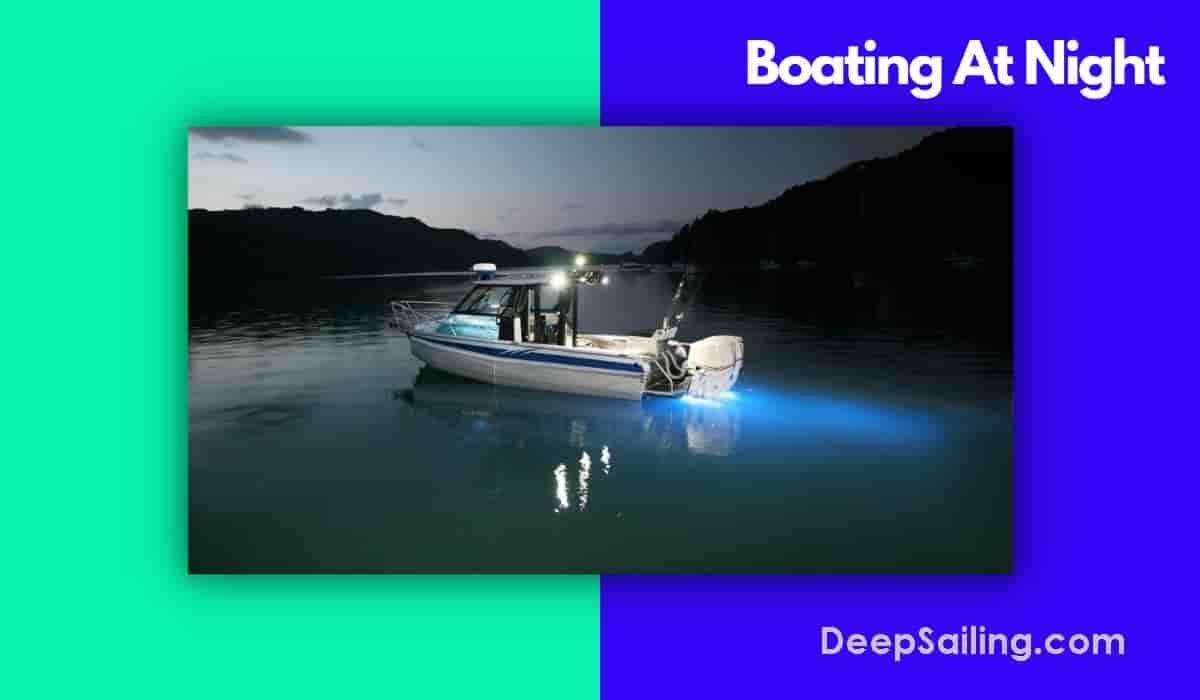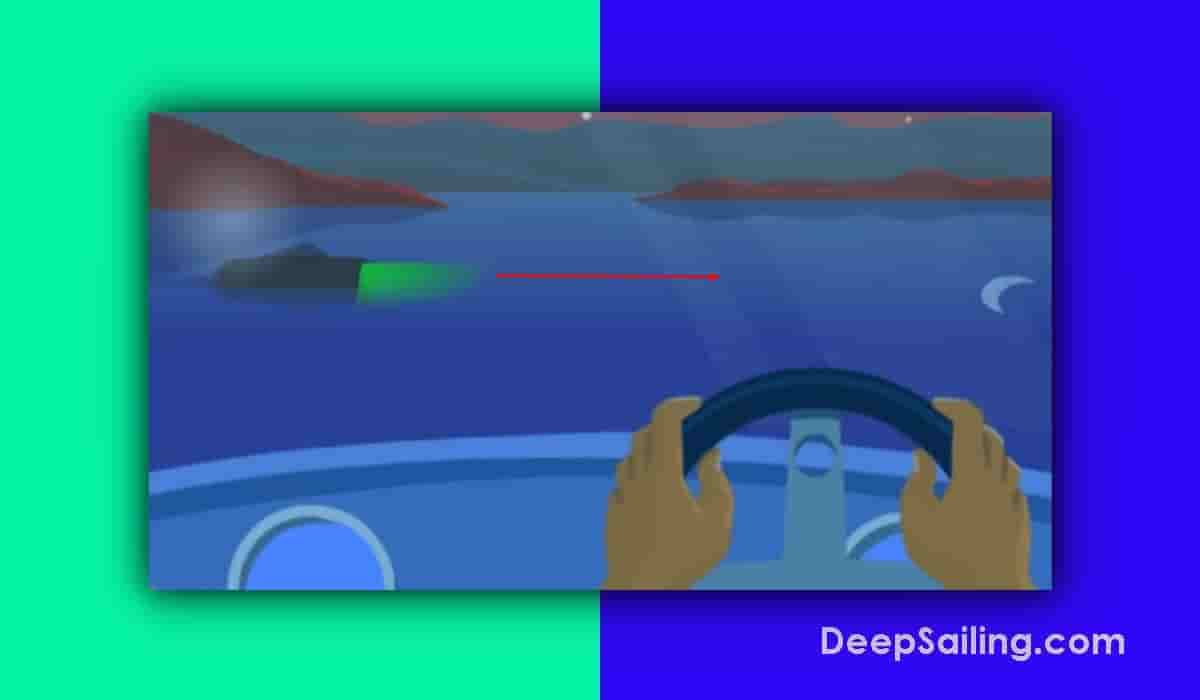
Boating at night can be enjoyable and relaxing to do. However, it is very important that boaters are safe and take care when boating after dark.
Boaters should know the navigation rules and boat safety requirements when boating at night.
To boat at night safely:
- Abide by night boating rules set out by the U.S. Coast Guard
- Ensure the boat equipment is working
- Understand & abide by the right of way rules when boating at night
- Adhere to boat safety rules
- Bring an extra passenger for lookout duties
Following these steps will ensure that boaters are in the best and most prepared position when going on a boat trip at night.
1. Abide By The Night Boating Rules Set Out By The U.S. Coast Guard
The first step to boating at night safely is to abide by the night boating rules set out by the U.S. Coast Guard or an equivalent official body in your country.
From the U.S. Coast Guard federal requirements for recreational boaters, the U.S. coast guard night boating rules are:
- All vessels under 164ft. in length must have a 360° shine all-around white anchor light that can be seen from all directions. This white anchor light should be placed at the top of a mast on a sailboat or on the roof of a power boat and it must be clearly visible with no obstruction to its visibility
- All vessels under 164ft. in length must have a portside red light and a starboard green light with a shine from dead ahead to 112.5° aft on either side. They must have a white stern light that shines aft and 67.5° forward. The red, white and green lights must be clearly visible with no obstruction to their visibility
- Visual distress signals must be carried onboard all vessels regardless of size at night including 3 U.S. coastguard approved pyrotechnic devices e.g. red flares, orange smoke signals or parachute flares and 1 U.S. coast guard approved non-pyrotechnic device e.g. high-intensity electric distress flashlight
- All recreational vessels must carry one wearable U.S. coast guard approved life jacket for each person on board. Any boat 16 feet or longer must also carry one throwable U.S. coast guard approved flotation device
- Hand-portable, U.S. Coast Guard-approved B-I or B-II classified fire extinguishers are required with a mounting bracket onboard boats. For boats less than 26 feet, one B-I fire extinguisher is required onboard, two B-I fire extinguishers or one B-II fire extinguisher are required onboard boats between 26 ft. and less than 40ft. and three B-I fire extinguishers are required on boats between 40 feet and 60ft.
Ensuring a boat complies with these rules means a boater is safely abiding by the U.S. coast guard rules for night boating and can safely and legally boat at night.
To meet the U.S. coast guard rules for night boating, ensure your boat has the correct lights, the right visual distress signal devices, fire extinguishers, and the required amount of personal flotation devices.
2. Ensure The Boating Equipment Is Working Properly
The second step to boating at night safely is to ensure all the boating equipment is working correctly.
To ensure the boating equipment is working when boating at night:
- Check the life jackets and personal flotation devices are working, fit perfectly on every person's body, and that there is no damage to them
- Ensure the red, white and green navigation lights on the boat are in full working order, are shining bright and there are no obstructions blocking the lights from view. If the lights are not working, replace the bulbs and fix all the lights before setting out on the water
- Ensure the deck and dock lights on the boat are working properly and they provide the correct amount of visibility in the dark
- Check the boat's fire extinguishers are all working and are mounted in an easily accessible area on the boat
- Assess the boat's navigational instruments like GPS, radars & chart plotters to ensure they are in full working order. Ensure the display brightness of these navigational instruments are perfect for boaters to clearly see and view in the dark and make sure they are providing the correct location readings so you can trust them when out boating at night
- Ensure the boat's engine starts and runs without any issues. Start the engine in the dock and let it sit idle for 2-3 minutes to see if there are any warning lights or engine misfire issues
- Check that all the boat's interior lights are working and replace the bulbs of any interior lights that are not working
Ensuring the boating equipment is in full working order should be done before going on a boating trip. It should not be done while out on the water after the boat has left the marina or harbor.
3. Understand & Abide By The Right Of Way Rules When Boating At Night
The third step to boating at night safely is to understand and abide by the right-of-way rules when boating at night.
These right-of-way rules explain how to safely pass a boat at night.
Below are different scenarios a boater will encounter when boating at night and what to do in these scenarios.
A Boater Sees A Boat Ahead With Green And White Lights

When boating at night, if you see another boat in front of you with a green and white light, it means the boat is crossing your path from the port side i.e. the boat is crossing your path from left to right.
In the scenario of seeing a boat with green and white lights ahead, you can maintain your course as this other vessel has to stop and give you the right of way.
However, still remain cautious in case the other vessel may not have seen you.
Put simply, if a boat is approaching your path from the left (port side), you have the right of way and the other vessel has to give way to you.
A Boater Sees A Boat Ahead With Red And White Lights

When boating at night, if you see another boat in front of you with a red and white light, it means the boat is crossing your path from the starboard side i.e. the boat is crossing your path from right to left.
In the scenario of seeing a boat with red and white lights ahead, you must slow down and stop to give the right of way to the other vessel. Remain slowed down or stopped until the other vessel passes your path and the path is now clear.
Put simply, if a boat is approaching your path from the right (the starboard side), this boat has the right of way and you must give way to them.
A Boater Sees A Boat Ahead With A Single White Light

When boating at night, if you see another boat in front of you with a single white light, it means the boat is at anchor or moving away from you in the same direction.
In the scenario of seeing a boat with a single white light ahead, you must slow down to avoid a collision or prepare to overtake the vessel on either side of the boat.
4. Adhere To Boat Safety Rules
The fourth step to boating at night safely is to adhere to common boat safety rules.
Boat safety rules to follow when boating at night includes:
- Wear a life jacket: As per U.S. coast guard rules, every person onboard a boat must wear a U.S. coast guard approved life jacket. Ensure every person is wearing a life jacket when boating at night
- Have fully functional fire extinguishers onboard: Make sure the fire extinguishers are operational and easily accessible in the event of a fire onboard at night
- Reduce boat speed at night: When boating at night, reduce your speed as the visibility is reduced at night. It can be hard to see debris or other boats at night so reducing the speed can help with this. It's recommended to travel slower than any boat speed limits
- Reduce the noise onboard: When boating at night, keep noise to a minimum. Keeping noise to a minimum ensures you can hear other boats approaching that you may not have seen. Playing music through speakers is not advised at night and keeping the rpm of the engine down to approximately 2,000 rpm or lower will help reduce the noise
- Don't use dock lights when out on the water: Dock lights should only be used when docking a boat in the harbor or marina and they should not be used when out boating at night. Using dock lights when out on the water at night can cause temporary blindness for other boaters and it is not recommended
- Bring waterproof jackets onboard at night: Sometimes the temperature can get very cold at night. To help with this, a boater should bring a waterproof jacket to keep them warm and dry when boating at night
- Follow the boat's navigational instruments at night: Follow the navigational instruments when boating at night. A navigational instrument will help inform you of other boater's locations and potential dangers on the water
Following and adhering to these marine safety rules will help boaters to safely navigate the waters when boating at night.
5. Bring An Extra Passenger For Lookout Duties
The fifth step to boating at night safely is to bring an extra passenger on the night boat trip for lookout duties.
An extra passenger onboard at night will help keep a lookout for other boats that a captain/skipper may not be able to see.
An extra passenger can keep a 360° lookout while a boat captain is focusing on navigational instruments.
Ideally, bring an adult over 18 years with good eyesight onboard for the lookout duties.
Boating A Night Safety Checklist
Before boating at night, a boater should follow a night boating safety checklist to ensure a safe boat trip at night.
Below is a boating at night safety checklist.
Frequently Asked Questions About Boating At Night
Below are commonly asked questions about boating at night.
What Color Are The Lights Of A Boat At Night?
The colors of the lights on a boat at night are red, green and white.
What Boat Lights Do You Need On A Boat At Night?
There are four lights needed on a boat when boating at night which are a red light on the port side of the vessel, a green light on the starboard side of the vessel, a white light at the stern of the boat, and a 360° visible white light on the highest point of a mast or roof of a boat.
How Do You Improve Your Safety When Boating At Night?
To improve your safety when boating at night, ensure all fire extinguishers and flares are operational, all the boat lights are in full working order, the life jackets are worn and tied correctly on your body, the navigation instruments are working and visible in the dark and the VHF radio is working properly.
What Are The Benefits Of Boating At Night?
The benefits of boating at night are fewer boats are on the water which means less crowded boating trips and the temperature at night tends to be much cooler which makes it more comfortable for boating in areas where the climate is hot.
What Are The Risks Of Boating At Night?
The risks of boating at night are poor visibility causing a boat collision and increased fatigue of the captain causing a lack of concentration when boating at night.
Is It Legal To Boat At Night?
Yes, it is legal to boat at night from sunset to sunrise provided the boater follows the rules and regulations set out by the U.S. Coast Guard or their own equivalent government body.
Is It Hard To Boat At Night?
No, boating at night is relatively straightforward once a boater gets some night boating experience. With more night boat trips, the boater gets more confident and it starts to become routine.
Is It Safe To Boat At Night?
Yes, it is safe to boat at night provided the boater follows the correct night boating safety procedures and ensures the weather conditions are good for nighttime boating.
If these safety procedures are followed and the weather is good, then it is safe.
When Is It Best Time To Boat At Night?
The best time to boat at night is when the weather conditions are good with clear skies and calm seas.
When Is It To Worst Time To Boat At Night?
The worst time to boat at night is when the weather is extremely foggy, there is a large amount of rain or it is very windy.
During poor weather conditions, boating at night should be avoided.
Do You Need Night Vision When Boating At Night?
No, night vision systems are not a legal requirement when boating at night. However, a night vision system can help improve a boater's visibility when night boating and many boaters find them useful to improve visibility.
What Is The Speed Limit When Boating At Night?
The speed limit when boating at night will depend on the specific states and their own marine speed limit laws.
Typically, nighttime boat speed limits range from 5 knots to 10 knots but this can vary depending on the state and the location.
Where Are The Boat Navigation Lights Located On A Boat When Boating At Night?
When boating at night, the boat navigation lights are located:
- Red light: The red light is located on the port side of the boat
- Green light: The green light is located on the starboard side of the boat
- White light: The white light is located on the top of a mast on a sailboat or on the rooftop of a power boat
What Are Boat Dock Lights?
Boat dock lights, also referred to as boat headlights, are lights on a boat that are turned on when a boat is docking in a marina or harbor. They are not used when a boat is moving on the water at night as they can temporarily blind other boaters and instead they are only turned on when a boat is mooring. The boat dock lights are located on the bow of a recreational boat.